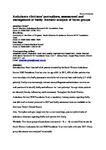Ambulance clinicians’ perceptions, assessment and management of frailty: thematic analysis of focus groups
| dc.contributor.author | Green, Jonathan | |
| dc.contributor.author | Kirby, K | |
| dc.contributor.author | Hope, S | |
| dc.date.accessioned | 2019-07-31T14:28:11Z | |
| dc.date.issued | 2018-12-01 | |
| dc.identifier.issn | 1478-4726 | |
| dc.identifier.issn | 1478-4726 | |
| dc.identifier.uri | http://hdl.handle.net/10026.1/14731 | |
| dc.description.abstract |
INTRODUCTION: More than half of all patients attended by the South Western Ambulance Service NHS Foundation Trust are over the age of 65. In 2017, 62% of older patients who were the subject of a frailty assessment were believed to have at least mild frailty (1/5 of all patients). Frailty is an increasingly relevant concept/diagnosis and ambulance services are well positioned to identify frailty and influence the 'care pathways' through which patients are directed (thereby influencing health outcomes). Throughout the South Western Ambulance Service NHS Foundation Trust, a mandatory training session regarding frailty was delivered to clinical personnel in 2017 and frailty assessment tools are available on the electronic Patient Clinical Record. AIM: To explore and gain insight into the current knowledge, practice and attitudes of ambulance clinicians regarding frailty and patients with frailty. METHODS: Two focus groups of ambulance clinicians (n = 8; n = 9) recruited from across the South Western Ambulance Service NHS Foundation Trust were held in October 2017. Focus group discussions were analysed thematically. RESULTS: Knowledge of conceptual models of frailty, appropriate assessment of patients with frailty and appropriate care pathways varied substantially among focus group participants. Completion of the 'Rockwood' Clinical Frailty Scale for relevant patients has become routine. However, conflicting opinions were expressed regarding the context and purpose of this. The Timed-Up-and-Go mobility assessment tool is also on the electronic Patient Clinical Record, but difficulties regarding its completion were expressed.Patient management strategies ranged from treatment options which the ambulance service can provide, to referrals to primary/community care which can support the management of patients in their homes, and options to refer patients directly to hospital units or specialists with the aim of facilitating appropriate assessment, treatment and discharge. Perceptions of limited availability and geographical variability regarding these referral pathways was a major feature of the discussions, raising questions regarding awareness, capacity, inter-professional relationships and patient choice. CONCLUSION: Knowledge, practice and attitudes of ambulance staff, with regard to frailty, varied widely. This reflected the emerging nature of the condition, both academically and clinically, within the ambulance profession and the wider healthcare system. | |
| dc.format.extent | 23-33 | |
| dc.format.medium | ||
| dc.language | en | |
| dc.language.iso | en | |
| dc.publisher | Class Publishing | |
| dc.subject | emergency medical services | |
| dc.subject | frailty | |
| dc.subject | referral and consultation | |
| dc.title | Ambulance clinicians’ perceptions, assessment and management of frailty: thematic analysis of focus groups | |
| dc.type | journal-article | |
| dc.type | Journal Article | |
| plymouth.author-url | https://www.ncbi.nlm.nih.gov/pubmed/33328809 | |
| plymouth.issue | 3 | |
| plymouth.volume | 3 | |
| plymouth.publication-status | Published | |
| plymouth.journal | British Paramedic Journal | |
| dc.identifier.doi | 10.29045/14784726.2018.12.3.3.23 | |
| plymouth.organisational-group | /Plymouth | |
| plymouth.organisational-group | /Plymouth/Faculty of Health | |
| plymouth.organisational-group | /Plymouth/Research Groups | |
| plymouth.organisational-group | /Plymouth/Research Groups/Plymouth Institute of Health and Care Research (PIHR) | |
| plymouth.organisational-group | /Plymouth/Users by role | |
| plymouth.organisational-group | /Plymouth/Users by role/Academics | |
| dc.publisher.place | England | |
| dcterms.dateAccepted | 2018-09-14 | |
| dc.rights.embargodate | 2020-2-7 | |
| dc.identifier.eissn | 1478-4726 | |
| dc.rights.embargoperiod | Not known | |
| rioxxterms.versionofrecord | 10.29045/14784726.2018.12.3.3.23 | |
| rioxxterms.licenseref.uri | http://www.rioxx.net/licenses/all-rights-reserved | |
| rioxxterms.licenseref.startdate | 2018-12-01 | |
| rioxxterms.type | Journal Article/Review |


